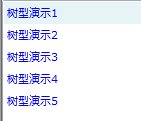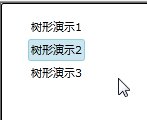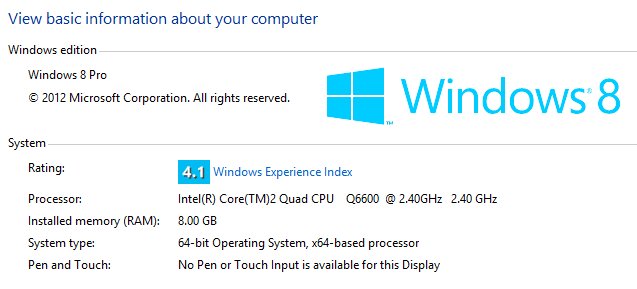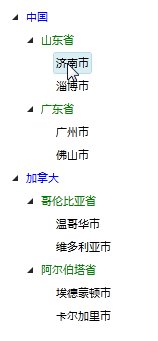详解Silverlight Treeview的HierarchicalDataTemplate使用
在Silverlight项目中,Treeview控件是比较常用的表示层次或者等级的控件,该控件可以非常清晰的显示数据之间的隶属关系。对于Treeview控件的基本使用已经有很多文章介绍,这里我想讲解一下Silverlight Treeivew的
HierarchicalDataTemplate的使用方法。
HierarchicalDataTemplate可以叫做"层级式数据模板",主要是应用层级比较明显数据集合。下面我来一步步演示
HierarchicalDataTemplate在Silverlight treeview中的使用方法。在演示中,我将引用另外一个Silverlight控件ListBox进行对比,因为,Treeview和Listbox都属于Itemscontrol,
所以有很多类似相同之处,通过对比能够帮助大家记忆以及使用该控件。
首先建立一个空的项目,

在MainPage页面中建立一个ListBox,在Xaml中写入代码,
1
<
UserControl
x:Class
="TreeviewDemo.MainPage"
2 xmlns ="http://schemas.microsoft.com/winfx/2006/xaml/presentation"
3 xmlns:x ="http://schemas.microsoft.com/winfx/2006/xaml"
4 xmlns:d ="http://schemas.microsoft.com/expression/blend/2008"
5 xmlns:mc ="http://schemas.openxmlformats.org/markup-compatibility/2006"
6 xmlns:sys ="clr-namespace:System;assembly=mscorlib"
7 mc:Ignorable ="d" d:DesignWidth ="640" d:DesignHeight ="480" >
8 < Grid x:Name ="LayoutRoot" >
9 < ListBox >
10 < sys:String > 树型演示1 </ sys:String >
11 < sys:String > 树型演示2 </ sys:String >
12 < sys:String > 树型演示3 </ sys:String >
13 < sys:String > 树型演示4 </ sys:String >
14 < sys:String > 树型演示5 </ sys:String >
15 </ ListBox >
16 </ Grid >
17 </ UserControl >
2 xmlns ="http://schemas.microsoft.com/winfx/2006/xaml/presentation"
3 xmlns:x ="http://schemas.microsoft.com/winfx/2006/xaml"
4 xmlns:d ="http://schemas.microsoft.com/expression/blend/2008"
5 xmlns:mc ="http://schemas.openxmlformats.org/markup-compatibility/2006"
6 xmlns:sys ="clr-namespace:System;assembly=mscorlib"
7 mc:Ignorable ="d" d:DesignWidth ="640" d:DesignHeight ="480" >
8 < Grid x:Name ="LayoutRoot" >
9 < ListBox >
10 < sys:String > 树型演示1 </ sys:String >
11 < sys:String > 树型演示2 </ sys:String >
12 < sys:String > 树型演示3 </ sys:String >
13 < sys:String > 树型演示4 </ sys:String >
14 < sys:String > 树型演示5 </ sys:String >
15 </ ListBox >
16 </ Grid >
17 </ UserControl >
运行后会显示:

在上面代码基础上,我们可以添加一个ItemTemplate,对数据进行绑定。
1
<
UserControl
x:Class
="TreeviewDemo.MainPage"
2 xmlns ="http://schemas.microsoft.com/winfx/2006/xaml/presentation"
3 xmlns:x ="http://schemas.microsoft.com/winfx/2006/xaml"
4 xmlns:d ="http://schemas.microsoft.com/expression/blend/2008"
5 xmlns:mc ="http://schemas.openxmlformats.org/markup-compatibility/2006"
6 xmlns:sys ="clr-namespace:System;assembly=mscorlib"
7 mc:Ignorable ="d" d:DesignWidth ="640" d:DesignHeight ="480" >
8 < Grid x:Name ="LayoutRoot" >
9 < ListBox >
10 < ListBox.ItemTemplate >
11 < DataTemplate >
12 < TextBlock Foreground ="Blue" Text =" {Binding} " />
13 </ DataTemplate >
14 </ ListBox.ItemTemplate >
15 < sys:String > 树型演示1 </ sys:String >
16 < sys:String > 树型演示2 </ sys:String >
17 < sys:String > 树型演示3 </ sys:String >
18 < sys:String > 树型演示4 </ sys:String >
19 < sys:String > 树型演示5 </ sys:String >
20 </ ListBox >
21 </ Grid >
22 </ UserControl >
23
2 xmlns ="http://schemas.microsoft.com/winfx/2006/xaml/presentation"
3 xmlns:x ="http://schemas.microsoft.com/winfx/2006/xaml"
4 xmlns:d ="http://schemas.microsoft.com/expression/blend/2008"
5 xmlns:mc ="http://schemas.openxmlformats.org/markup-compatibility/2006"
6 xmlns:sys ="clr-namespace:System;assembly=mscorlib"
7 mc:Ignorable ="d" d:DesignWidth ="640" d:DesignHeight ="480" >
8 < Grid x:Name ="LayoutRoot" >
9 < ListBox >
10 < ListBox.ItemTemplate >
11 < DataTemplate >
12 < TextBlock Foreground ="Blue" Text =" {Binding} " />
13 </ DataTemplate >
14 </ ListBox.ItemTemplate >
15 < sys:String > 树型演示1 </ sys:String >
16 < sys:String > 树型演示2 </ sys:String >
17 < sys:String > 树型演示3 </ sys:String >
18 < sys:String > 树型演示4 </ sys:String >
19 < sys:String > 树型演示5 </ sys:String >
20 </ ListBox >
21 </ Grid >
22 </ UserControl >
23
运行结果如下:

这里ListBox的选项都变成了蓝色。
就像我们前面所说的,ListBox是一个ItemsControl,任何ItemsControl都是相同的,可以将它们的内容包括到一个容器中。所以,我们可以再次重写上面代码:
1
<
UserControl
x:Class
="TreeviewDemo.MainPage"
2 xmlns ="http://schemas.microsoft.com/winfx/2006/xaml/presentation"
3 xmlns:x ="http://schemas.microsoft.com/winfx/2006/xaml"
4 xmlns:d ="http://schemas.microsoft.com/expression/blend/2008"
5 xmlns:mc ="http://schemas.openxmlformats.org/markup-compatibility/2006"
6 xmlns:sys ="clr-namespace:System;assembly=mscorlib"
7 mc:Ignorable ="d" d:DesignWidth ="640" d:DesignHeight ="480" >
8 < Grid x:Name ="LayoutRoot" >
9 < ListBox >
10
11
12 < ListBoxItem Content ="树型演示1" >
13 < ListBoxItem.ContentTemplate >
14 < DataTemplate x:Name ="myTemplate" >
15 < TextBlock Foreground ="Blue" Text =" {Binding} " />
16 </ DataTemplate >
17 </ ListBoxItem.ContentTemplate >
18 </ ListBoxItem >
19 < ListBoxItem Content ="树型演示2" ContentTemplate =" {Binding ElementName=myTemplate} " />
20 < ListBoxItem Content ="树型演示3" ContentTemplate =" {Binding ElementName=myTemplate} " />
21 < ListBoxItem Content ="树型演示4" ContentTemplate =" {Binding ElementName=myTemplate} " />
22 < ListBoxItem Content ="树型演示5" ContentTemplate =" {Binding ElementName=myTemplate} " />
23 </ ListBox >
24 </ Grid >
25 </ UserControl >
26
2 xmlns ="http://schemas.microsoft.com/winfx/2006/xaml/presentation"
3 xmlns:x ="http://schemas.microsoft.com/winfx/2006/xaml"
4 xmlns:d ="http://schemas.microsoft.com/expression/blend/2008"
5 xmlns:mc ="http://schemas.openxmlformats.org/markup-compatibility/2006"
6 xmlns:sys ="clr-namespace:System;assembly=mscorlib"
7 mc:Ignorable ="d" d:DesignWidth ="640" d:DesignHeight ="480" >
8 < Grid x:Name ="LayoutRoot" >
9 < ListBox >
10
11
12 < ListBoxItem Content ="树型演示1" >
13 < ListBoxItem.ContentTemplate >
14 < DataTemplate x:Name ="myTemplate" >
15 < TextBlock Foreground ="Blue" Text =" {Binding} " />
16 </ DataTemplate >
17 </ ListBoxItem.ContentTemplate >
18 </ ListBoxItem >
19 < ListBoxItem Content ="树型演示2" ContentTemplate =" {Binding ElementName=myTemplate} " />
20 < ListBoxItem Content ="树型演示3" ContentTemplate =" {Binding ElementName=myTemplate} " />
21 < ListBoxItem Content ="树型演示4" ContentTemplate =" {Binding ElementName=myTemplate} " />
22 < ListBoxItem Content ="树型演示5" ContentTemplate =" {Binding ElementName=myTemplate} " />
23 </ ListBox >
24 </ Grid >
25 </ UserControl >
26
在上面的代码中,ListBox中创建五个ListBoxItem,ListBoxItem的Content属性绑定着不同的选项,而ListBoxItem的ContentTemplate绑定着ListBox的ItemTemplate。
运行结果和上面的相同:

根据上面的基础,我们可以使用同样的概念来理解Silverlight Treeivew控件。
在使用Treeview控件前,需要添加引用,Treeview控件被装配在System.Windows.Controls下,另外在客户端页面需要添加命名空间如下:
xmlns:Controls="clr-namespace:System.Windows.Controls;assembly=System.Windows.Controls"
Treeview控件也是一个ItemsControl,同样,每次初始化,Treeview控件会为所属选项创建TreeViewItem。 如果我们使用和ListBox同样的代码,可以得到下面结果,
1
<
UserControl
x:Class
="TreeviewDemo.MainPage"
2 xmlns ="http://schemas.microsoft.com/winfx/2006/xaml/presentation"
3 xmlns:x ="http://schemas.microsoft.com/winfx/2006/xaml"
4 xmlns:d ="http://schemas.microsoft.com/expression/blend/2008"
5 xmlns:mc ="http://schemas.openxmlformats.org/markup-compatibility/2006"
6 xmlns:sys ="clr-namespace:System;assembly=mscorlib"
7 xmlns:Controls ="clr-namespace:System.Windows.Controls;assembly=System.Windows.Controls"
8 mc:Ignorable ="d" d:DesignWidth ="640" d:DesignHeight ="480" >
9 < Grid x:Name ="LayoutRoot" >
10 < Controls:TreeView >
11 < sys:String > 树形演示1 </ sys:String >
12 < sys:String > 树形演示2 </ sys:String >
13 < sys:String > 树形演示3 </ sys:String >
14 </ Controls:TreeView >
15 </ Grid >
16 </ UserControl >
17
2 xmlns ="http://schemas.microsoft.com/winfx/2006/xaml/presentation"
3 xmlns:x ="http://schemas.microsoft.com/winfx/2006/xaml"
4 xmlns:d ="http://schemas.microsoft.com/expression/blend/2008"
5 xmlns:mc ="http://schemas.openxmlformats.org/markup-compatibility/2006"
6 xmlns:sys ="clr-namespace:System;assembly=mscorlib"
7 xmlns:Controls ="clr-namespace:System.Windows.Controls;assembly=System.Windows.Controls"
8 mc:Ignorable ="d" d:DesignWidth ="640" d:DesignHeight ="480" >
9 < Grid x:Name ="LayoutRoot" >
10 < Controls:TreeView >
11 < sys:String > 树形演示1 </ sys:String >
12 < sys:String > 树形演示2 </ sys:String >
13 < sys:String > 树形演示3 </ sys:String >
14 </ Controls:TreeView >
15 </ Grid >
16 </ UserControl >
17
运行结果:

同样,也可以添加ItemTemplate到Treeview控件,
1
<
UserControl
x:Class
="TreeviewDemo.MainPage"
2 xmlns ="http://schemas.microsoft.com/winfx/2006/xaml/presentation"
3 xmlns:x ="http://schemas.microsoft.com/winfx/2006/xaml"
4 xmlns:d ="http://schemas.microsoft.com/expression/blend/2008"
5 xmlns:mc ="http://schemas.openxmlformats.org/markup-compatibility/2006"
6 xmlns:sys ="clr-namespace:System;assembly=mscorlib"
7 xmlns:Controls ="clr-namespace:System.Windows.Controls;assembly=System.Windows.Controls"
8 mc:Ignorable ="d" d:DesignWidth ="640" d:DesignHeight ="480" >
9 < Grid x:Name ="LayoutRoot" >
10 < Controls:TreeView >
11 < Controls:TreeView.ItemTemplate >
12 < DataTemplate >
13 < TextBlock Foreground ="Green" Text =" {Binding} " />
14 </ DataTemplate >
15 </ Controls:TreeView.ItemTemplate >
16 < sys:String > 树型演示1 </ sys:String >
17 < sys:String > 树型演示2 </ sys:String >
18 < sys:String > 树型演示3 </ sys:String >
19 </ Controls:TreeView >
20 </ Grid >
21 </ UserControl >
22
2 xmlns ="http://schemas.microsoft.com/winfx/2006/xaml/presentation"
3 xmlns:x ="http://schemas.microsoft.com/winfx/2006/xaml"
4 xmlns:d ="http://schemas.microsoft.com/expression/blend/2008"
5 xmlns:mc ="http://schemas.openxmlformats.org/markup-compatibility/2006"
6 xmlns:sys ="clr-namespace:System;assembly=mscorlib"
7 xmlns:Controls ="clr-namespace:System.Windows.Controls;assembly=System.Windows.Controls"
8 mc:Ignorable ="d" d:DesignWidth ="640" d:DesignHeight ="480" >
9 < Grid x:Name ="LayoutRoot" >
10 < Controls:TreeView >
11 < Controls:TreeView.ItemTemplate >
12 < DataTemplate >
13 < TextBlock Foreground ="Green" Text =" {Binding} " />
14 </ DataTemplate >
15 </ Controls:TreeView.ItemTemplate >
16 < sys:String > 树型演示1 </ sys:String >
17 < sys:String > 树型演示2 </ sys:String >
18 < sys:String > 树型演示3 </ sys:String >
19 </ Controls:TreeView >
20 </ Grid >
21 </ UserControl >
22
运行结果:

从上面,我们可以看出,ListBox和Treeview有很多相似之处,在一些情况下基本可以替换使用,但是,这两个控件也有明显的区别。TreeView控件在建立选项的时候,使用的是 TreeViewItem类,而TreeViewItem是HeaderedItemsControl(详细定义可以查看MSDN http://msdn.microsoft.com/en-us/library/system.windows.controls.treeviewitem(VS.95).aspx),作为HeaderedItemsControl,可以将控件选项内容赋值到Header或者HeaderTemplate属性中。
这里,我们可以简单的理解,HeaderedItemsControl的Header/HeaderTemplate和ContentControl的Content/ContentTemplate功能是相同的,都是呈现内容的载体。 所以,在ListBox中,选项是被绑定到ListBoxItem的content属性中,而在Treeview控件中,选项是被绑定到TreeViewItem的Header属性中。同样,TreeView的ItemTemplate绑定也可以使用TreeviewItem的HeaderTemplate属性进行绑定,结果是相同的。根据上面所述,可以得到下面的代码:
1
<
UserControl
x:Class
="TreeviewDemo.MainPage"
2 xmlns ="http://schemas.microsoft.com/winfx/2006/xaml/presentation"
3 xmlns:x ="http://schemas.microsoft.com/winfx/2006/xaml"
4 xmlns:d ="http://schemas.microsoft.com/expression/blend/2008"
5 xmlns:mc ="http://schemas.openxmlformats.org/markup-compatibility/2006"
6 xmlns:sys ="clr-namespace:System;assembly=mscorlib"
7 xmlns:Controls ="clr-namespace:System.Windows.Controls;assembly=System.Windows.Controls"
8 mc:Ignorable ="d" d:DesignWidth ="640" d:DesignHeight ="480" >
9 < Grid x:Name ="LayoutRoot" >
10 < Controls:TreeView >
11 < Controls:TreeViewItem Header ="树型演示1" >
12 < Controls:TreeViewItem.HeaderTemplate >
13 < DataTemplate x:Name ="myTemplate" >
14 < TextBlock Foreground ="Green" Text =" {Binding} " />
15 </ DataTemplate >
16 </ Controls:TreeViewItem.HeaderTemplate >
17 </ Controls:TreeViewItem >
18 < Controls:TreeViewItem Header ="树型演示2" HeaderTemplate =" {Binding ElementName=myTemplate} " />
19 < Controls:TreeViewItem Header ="树型演示3" HeaderTemplate =" {Binding ElementName=myTemplate} " />
20 </ Controls:TreeView >
21 </ Grid >
22 </ UserControl >
23
2 xmlns ="http://schemas.microsoft.com/winfx/2006/xaml/presentation"
3 xmlns:x ="http://schemas.microsoft.com/winfx/2006/xaml"
4 xmlns:d ="http://schemas.microsoft.com/expression/blend/2008"
5 xmlns:mc ="http://schemas.openxmlformats.org/markup-compatibility/2006"
6 xmlns:sys ="clr-namespace:System;assembly=mscorlib"
7 xmlns:Controls ="clr-namespace:System.Windows.Controls;assembly=System.Windows.Controls"
8 mc:Ignorable ="d" d:DesignWidth ="640" d:DesignHeight ="480" >
9 < Grid x:Name ="LayoutRoot" >
10 < Controls:TreeView >
11 < Controls:TreeViewItem Header ="树型演示1" >
12 < Controls:TreeViewItem.HeaderTemplate >
13 < DataTemplate x:Name ="myTemplate" >
14 < TextBlock Foreground ="Green" Text =" {Binding} " />
15 </ DataTemplate >
16 </ Controls:TreeViewItem.HeaderTemplate >
17 </ Controls:TreeViewItem >
18 < Controls:TreeViewItem Header ="树型演示2" HeaderTemplate =" {Binding ElementName=myTemplate} " />
19 < Controls:TreeViewItem Header ="树型演示3" HeaderTemplate =" {Binding ElementName=myTemplate} " />
20 </ Controls:TreeView >
21 </ Grid >
22 </ UserControl >
23
运行结果和上面相同:

相信通过上面的演示,大家已经基本理解ItemsControl的Template使用,根据上述,我们可以延伸到HierarchicalDataTemplate,使用HierarchicalDataTemplate我们需要建立一个例程数据类供TreeView调用。
1
public
class
Country
2 {
3 public Country()
4 {
5 Privinces = new ObservableCollection < Province > ();
6 }
7
8 public string Name { get ; set ; }
9 public ObservableCollection < Province > Privinces { get ; set ; }
10 }
11
12 public class Province
13 {
14 public Province()
15 {
16 Citys = new ObservableCollection < City > ();
17 }
18
19 public string Name { get ; set ; }
20 public ObservableCollection < City > Citys { get ; set ; }
21 }
22
23 public class City
24 {
25 public string Name { get ; set ; }
26 }
2 {
3 public Country()
4 {
5 Privinces = new ObservableCollection < Province > ();
6 }
7
8 public string Name { get ; set ; }
9 public ObservableCollection < Province > Privinces { get ; set ; }
10 }
11
12 public class Province
13 {
14 public Province()
15 {
16 Citys = new ObservableCollection < City > ();
17 }
18
19 public string Name { get ; set ; }
20 public ObservableCollection < City > Citys { get ; set ; }
21 }
22
23 public class City
24 {
25 public string Name { get ; set ; }
26 }
然后建立例程数据,代码如下:

 代码
代码
1
tvDemo.ItemsSource
=
new
ObservableCollection
<
Country
>
{
2 new Country {
3 Name = " 中国 " ,
4 Privinces = { new Province
5 {
6 Name = " 山东省 " ,
7 Citys = {
8 new City { Name = " 济南市 " },
9 new City { Name = " 淄博市 " }
10 }
11 },
12 new Province
13 {
14 Name = " 广东省 " ,
15 Citys = {
16 new City { Name = " 广州市 " },
17 new City { Name = " 佛山市 " }
18 }
19 }
20 }
21 },
22 new Country {
23 Name = " 加拿大 " ,
24 Privinces = { new Province
25 {
26 Name = " 哥伦比亚省 " ,
27 Citys = {
28 new City { Name = " 温哥华市 " },
29 new City { Name = " 维多利亚市 " }
30 }
31 },
32 new Province
33 {
34 Name = " 阿尔伯塔省 " ,
35 Citys = {
36 new City { Name = " 埃德蒙顿市 " },
37 new City { Name = " 卡尔加里市 " }
38 }
39 }
40 }
41 }
42 };
2 new Country {
3 Name = " 中国 " ,
4 Privinces = { new Province
5 {
6 Name = " 山东省 " ,
7 Citys = {
8 new City { Name = " 济南市 " },
9 new City { Name = " 淄博市 " }
10 }
11 },
12 new Province
13 {
14 Name = " 广东省 " ,
15 Citys = {
16 new City { Name = " 广州市 " },
17 new City { Name = " 佛山市 " }
18 }
19 }
20 }
21 },
22 new Country {
23 Name = " 加拿大 " ,
24 Privinces = { new Province
25 {
26 Name = " 哥伦比亚省 " ,
27 Citys = {
28 new City { Name = " 温哥华市 " },
29 new City { Name = " 维多利亚市 " }
30 }
31 },
32 new Province
33 {
34 Name = " 阿尔伯塔省 " ,
35 Citys = {
36 new City { Name = " 埃德蒙顿市 " },
37 new City { Name = " 卡尔加里市 " }
38 }
39 }
40 }
41 }
42 };
首先我们使用TreeView的ItemTemplate来显示该数据树形结构,前台代码:
1
<
Controls:TreeView
x:Name
="tvDemo"
>
2 < Controls:TreeView.ItemTemplate >
3 < DataTemplate >
4 < TextBlock Text =" {Binding Name} " />
5 </ DataTemplate >
6 </ Controls:TreeView.ItemTemplate >
7 </ Controls:TreeView >
2 < Controls:TreeView.ItemTemplate >
3 < DataTemplate >
4 < TextBlock Text =" {Binding Name} " />
5 </ DataTemplate >
6 </ Controls:TreeView.ItemTemplate >
7 </ Controls:TreeView >
显示结果如下:

这里Treeview控件建立了两个TreeViewItems,并且绑定TreeViewitem的Header属性到Country对象,而且将TreeViewItem的HeaderTemplate设置为TreeView的ItemTemplate。下面,我们需要子数据同时绑定到Treeview控件中,这里我们需要使用HierarchicalDataTemplate。在使用HierarchicalDataTemplate前,需要声明新的命名空间:
xmlns:common="clr-namespace:System.Windows;assembly=System.Windows.Controls"
其实HierarchicalDataTemplate是一个带有多个扩展属性DataTemplate。 如果我们不使用这些扩展属性,HierarchicalDataTemplate和普通DataTemplate是相同的,例如,我们修改上面代码:
1
<
Controls:TreeView
x:Name
="tvDemo"
>
2 < Controls:TreeView.ItemTemplate >
3 < common:HierarchicalDataTemplate >
4 < TextBlock Text =" {Binding Name} " />
5 </ common:HierarchicalDataTemplate >
6 </ Controls:TreeView.ItemTemplate >
7 </ Controls:TreeView >
8
2 < Controls:TreeView.ItemTemplate >
3 < common:HierarchicalDataTemplate >
4 < TextBlock Text =" {Binding Name} " />
5 </ common:HierarchicalDataTemplate >
6 </ Controls:TreeView.ItemTemplate >
7 </ Controls:TreeView >
8
显示结果和上面相同:

所谓HierarchicalDataTemplate的扩展属性,主要是ItemsSource和ItemTemplate两个属性。其中ItemsSource属性可以获取TreeView.ItemsSource的数据,ItemTemplate可以获取到TreeViewItem.ItemTemplate模板。根据这两个属性,我们可以修改以上代码,获取到子数据。通常来说,我们会把HierarchicalDataTemplate定义在Resource中,这样可以使代码布局整洁,另外提高易读性。
1
<
UserControl.Resources
>
2 < common:HierarchicalDataTemplate x:Key ="CityTemplate" >
3 < StackPanel >
4 < TextBlock Text =" {Binding Name} " />
5 </ StackPanel >
6 </ common:HierarchicalDataTemplate >
7 < common:HierarchicalDataTemplate x:Key ="ProvinceTemplate" ItemsSource =" {Binding Citys} " ItemTemplate =" {StaticResource CityTemplate} " >
8 < StackPanel >
9 < TextBlock Text =" {Binding Name} " Foreground ="Green" />
10 </ StackPanel >
11 </ common:HierarchicalDataTemplate >
12 < common:HierarchicalDataTemplate x:Key ="CountryTemplate" ItemsSource =" {Binding Privinces} " ItemTemplate =" {StaticResource ProvinceTemplate} " >
13 < TextBlock Text =" {Binding Name} " Foreground ="Blue" />
14 </ common:HierarchicalDataTemplate >
15 </ UserControl.Resources >
2 < common:HierarchicalDataTemplate x:Key ="CityTemplate" >
3 < StackPanel >
4 < TextBlock Text =" {Binding Name} " />
5 </ StackPanel >
6 </ common:HierarchicalDataTemplate >
7 < common:HierarchicalDataTemplate x:Key ="ProvinceTemplate" ItemsSource =" {Binding Citys} " ItemTemplate =" {StaticResource CityTemplate} " >
8 < StackPanel >
9 < TextBlock Text =" {Binding Name} " Foreground ="Green" />
10 </ StackPanel >
11 </ common:HierarchicalDataTemplate >
12 < common:HierarchicalDataTemplate x:Key ="CountryTemplate" ItemsSource =" {Binding Privinces} " ItemTemplate =" {StaticResource ProvinceTemplate} " >
13 < TextBlock Text =" {Binding Name} " Foreground ="Blue" />
14 </ common:HierarchicalDataTemplate >
15 </ UserControl.Resources >
在Resource中设置完HierarchicalDataTemplate,在TreeView控件中调用ItemTemplate就可以了。
<
Controls:TreeView
x:Name
="tvDemo"
ItemTemplate
="
{StaticResource CountryTemplate}
"
></
Controls:TreeView
>
显示结果如下:

值得注意的是,在定义资源文件的时候,设置 CityTemplate, ProvinceTemplate和CountryTemplate
的顺序不能交换,否则无法查找到相关资源模板,同时,该资源文件也需要放在TreeView控件声明前,否则也是无法找到相关资源模板。
感谢 银光中国网 ( SilverlightChina.Net) 提供空间发布代码和演示。
在线演示: http://silverlightchina.net/html/tips/2009/1211/391.html
源码下载: http://silverlightchina.net/uploads/soft/091211/1-091211164055.zip